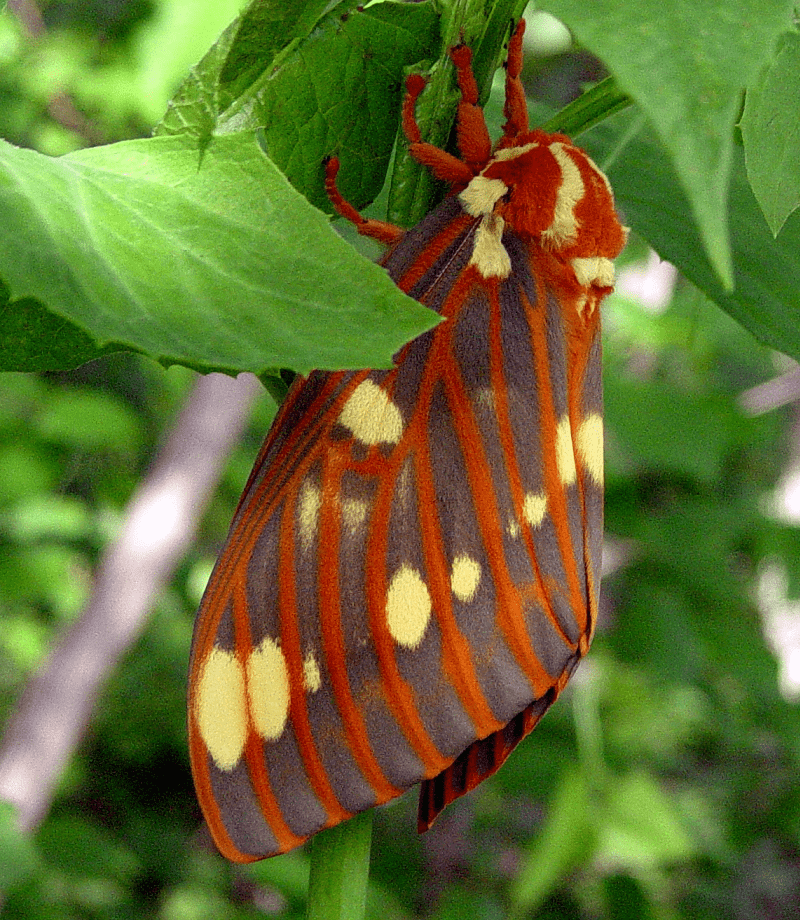Regal Moth Facts
- Notably, term of Regal Moth represents only one of the common names associated with this stunning Lepidoptera. That’s because it also goes by the alternate term of the royal walnut moth. Both names describe it well, just in different ways.
- The scientific name for it, however, remains that of the hard to pronounce Citheronia regalis. By either term, though, it constitutes one of them most incredible moths in the world. This further holds true in terms of both its size and beauty.
- The highly respected Danish zoologist, Johan Christian Fabricius, made the first known recognition of the amazing creature. This formal acknowledgement of the astounding invertebrate as a separate and distinct species occurred in the year 1793.
- Quite understandably, it qualifies as one of the largest insects of its kind in its native range. Its larval form, however, perhaps receives more recognition than the adult. Known as the Hickory Horned Devil, its frequently viewed as a major pest.
- Fortunately, the Regal Moth appears to have a sufficient and stable population. This also seems to hold true throughout the entirety of its natural range. The IUCN therefore currently has no listing for the insect on its Red List of Threatened Species.
- It does nonetheless face several potential threats to its continued existence. Habitat loss, due to human expansion, certainly qualifies as one. The greatest danger it faces, however, no doubt comes in the form on the ongoing effects of climate change.
Related Articles
Regal Moth Physical Description
The magnificent Regal Moth easily earns its name. That’s because it clearly stands out from many of its peers in terms of pure beauty. It nevertheless impresses those who encounter it for yet another reason though. That’s due to the sheer size of the marvelous insect.
The pure awesomeness Nature blessed this Lepidoptera with doesn’t stop there, though. The fascinating species also displays a slight degree of the physiological trait of sexual dimorphism. In its specific case, this characteristic manifests itself in terms of physical size.
More precisely, females grow slightly larger than males. Overall, however, a maximum wingspan for the females equals roughly 6 in (15 cm). It’s also relatively bulky, in terms of mass. In point of fact, it ranks as the heaviest variety of moth in its part of the world.
Its great beauty nevertheless merits a degree of appreciation at least equal to its size. The forewings of the invertebrate typically present as either a gray or gray-green in color. These beautiful, but delicate, structures further display a row of small, bright yellow spots.
The hind wings, meanwhile, manifest a strikingly different pattern of color. That’s because these develop as primarily orange with yellow patches. The marvels don’t end there, though. The body of the awesome insect usually appears a dull orange with yellow bands.
Even the caterpillar form of the Regal Moth presents a wonder to the eye of the beholder. That’s due to both their color and size. Individuals present a mainly light blue-green color, along with an orange tail, head, and horns. It also averages 4.7 – 5.5 (12 – 14 cm) long.
- Kingdom: Animalia
- Phylum: Euarthropoda
- Class: Insecta
- Order: Lepidoptera
- Family: Saturniidae
- Genus: Citheronia
- Species: C. regalis
Regal Moth Distribution, Habitat, and Ecology
Most unfortunately, Nature limited the presence of the breathtaking Regal Moth in the world. The moth evolved as natural to a moderately limited section of the globe. More precisely, the insect only appears natively in a comparatively small portion of North America.
That’s due to the fact that it appears naturally only in a specific portion of the United States. It further lives only in the eastern sections of the country. That range extends from New Jersey to Missouri, to eastern Texas and central Florida, and all points east of those.
Even within that range, though, its population remains somewhat clumped. The lovely insect currently remains more common in the southern sections of this range. The precise reason for this tendency, however, currently remains undetermined by researchers.
The Regal Moth also displays a decided preference regarding its precise habitat. While it will stay in a restricted variety of tree species if its preferred choices remain unavailable, it greatly prefers walnut and hickory trees. This also leads to the term for its larval form.
After mating, the females spend most of the rest of their lives laying eggs. The male, meanwhile, frequently mates several more times before he dies. Like other moths, it evolved as a nocturnal species. Bats form its leading predator, along with certain types of flies.
Species Sharing Its Range
Check out our other articles on 6 Geological Wonders of India, Nicobar Pigeon, Rio Negro River, Arrowleaf Elephant Ear, Red-Shanked Douc, Crocodilefish, Cairns Birdwing, Rainbow Snake

